The stick next to the rock is man’s oldest and perhaps longest existing weapon. Its use as an offensive tool can be found in cave paintings portraying prehistoric society. Evidence exists that the ancient Egyptians had systemised methods of training with sticks of varying configurations.
At one time, every country in Europe had its own indigenous form of stick fighting. During the 1800s the cane or walking stick was an indispensable fashion accessory that accompanied every gentlemen that walked the streets of Europe . While the walking stick offered stability and assisted in preventing simple falls, it was in trained hands, an item capable of averting personal assault. As an instrument of personal defence the French developed the walking stick into a formidable weapon.
The techniques were assimilated from various sources including the Sabre, the cut and thrust sword, Savate and Boxing. This French method became known as la canne.
The French army incorporated la canne into its training curriculum as a means of developing fitness, inner fortitude and bonding by way of competitions with other regiments. The Joinville Military Academy provided compulsory four-month courses in physical culture, which covered, among other things, training in la canne, baton, Savate, fencing and hand to hand combat.
Towards the end of the nineteenth century a professor named Pierre Vigny became renowned for teaching a lethal form of la canne. It was reported that Vigny would test his skills by making nightly excursions into the roughest areas of Marseilles, Paris and Genoa to many a gambling den and drinking hole where he would scrap with any man who would step up to the line.
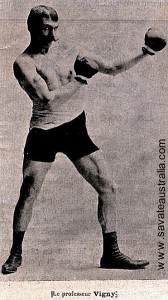
Vigny was an accomplished professor of Savate, boxing, fencing, wrestling and Ju-Jitsu. He served as the fencing master for the Second Regiment of the French Artillery and was, for a period of time, a Professor of Arms at the Geneva Academy of Fencing. Vigny also held the position of Chief Instructor at The Bartitsu School and introduced la canne to England .
E.W Barton-Wright comments on the influence of the Vigny method –
“After some 15 years of hard work, such a system has been devised by a Swiss professor of arms, M. Vigny .It has recently been assimilated by me into my own system of self –defence called Bartitisu.”
The Vigny method of stick fighting was not as elegant as the academic and sportive systems but lent itself well to street brawls and riots. The skills were anything but complicated and the most direct and efficient attacks were adopted into this combat system of la canne.
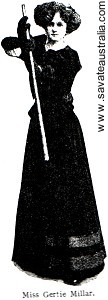
Gertie Millar ( later to become lady Dudley ) one of the most respected stage performers of the Edwardian era was an avid practitioner of the walking stick and umbrella method of self- defence ” – picture courtesy of Ralph Grasso
Percy Longhurst author of “Jiu-Jitsu and other Methods of Self-Defence” writes-
“It is impossible to convey on paper any idea of the marvellous system of strokes and parries this master (Vigny) has evolved. Against one skilled in his system half a dozen assailants would be powerless, so irrepressibly effective is the use he teaches of the ordinary thick Malacca cane”
The preferred stick that embraced all the qualities necessary to facilitate these efficient skills was constructed from a medium weight Malacca cane with a metal ball attached to one end. The “Vigny Self Defence Stick” was sturdy and heavy enough to allow the metal head to be used as the point of percussion, offering additional weight to the stick. Vigny, who considered its use unrealistic for street defence, shunned the lighter assault cane popular among the academic salles.
Let’s examine several prime skill components of the Vigny’s stick fighting method.
The High Guard
The high guard was advocated as the prime position for attack and defence. Standing with the left side forward (for a right handed person) the rear arm was raised above the head and the point of the walking stick sighted at the opponent’s eyes, the lead arm was extended forward off the bodyline. The chosen grip to accompany this combat guard was a full handed one or fist grip with the thumb folded across the fingers and not along the shaft of the stick. Unlike the waist orientated guards, which require one to first raise or retract the weapon to generate sufficient striking power, the high guard position, as advocated in the Vigny method, preps the weapon ready to strike with very little evidence of one’s intent.
Another benefit of the high guard structure was the additional protection it offered to the weapon-bearing limb. Cuts to the hand and arms were not only permitted but also encouraged.

Defensive Skills
Counter cutting in conjunction with footwork was considered the most effective means of defence. When attacked by an assailant, one needed to rapidly retire by passing the leading foot back while simultaneously bringing the weapon down hard onto any open target. While Vigny considered the parry and riposte a secondary method of defence his high guard structure offered superb shielding capabilities that could combat a wide range of weapon attacks from both single and multiple attackers. With a simple movement of the wrist, the head, face and flanks could be quickly guarded. If pressed at close quarters both hands could be used to grasp the stick and guard a multitude of attacks.

Offensive Skills
Pierre Vigny incorporated various ways of attacking with the walking stick.
Held with one or both hands the stick was used to deliver cuts or strikes to a variety of targets including the face, head, neck, clavicle, ribs, elbows, wrists, knees and the shins.
Strikes using Vigny’s metal-headed walking stick were facilitated for the most part by the wrist and unlike a thin lighter cane which requires one to use a larger swinging movement to empower the strike, formidable blows could be generated using a simple wrist action.
The short end of the stick, protruding from the edge of the hand, was used as a dagger at close quarters while long-range thrusts were delivered by sliding the stick in a pool cue fashion through the hand.

While all offensive and counter techniques were initially learnt from one’s strong side, training of the body’s less coordinated side was also emphasised. The left arm, while not as coordinated as the right, still needed to be able to deliver powerful cuts. This ambidextrous approach was considered important especially in the case of the primary arm being injured or incapacitated.
Alfred Hutton author of “The Sword And The Centuries” 1901 points out –
“ For the man can, and does, frisk his cane about from one hand to another, so that his opponent can never precisely tell which hand will deliver the attack, and careful practise of the various lessons will shortly make the student pretty nearly ambidextrous. M. Vigny does not confine himself to teaching a mere exhilarating game of play; he shows his pupils also the more serious side of the system, instructing them carefully in what they should do if attacked by a gang of ruffians”.
Entry Manoeuvres and Disarming
Entry manoeuvres, disarming and infighting played an important role in the Vigny method of la canne. Used only when the opponent possessed superior striking capabilities or was welding a much heavier weapon to one’s own, these entry manoeuvres were initiated while attacking the opponent or guarding his attack. Maintaining a constant forward pressure the free hand could lift, push or pin the opponent’s weapon-bearing limb. Kicks, sweeps, back heels, throws and off hand hits were effective follow ups used to disrupt both the enemy’s balance and ability to attack. A disarmed or grounded opponent was by no means incapable of attack, and where the circumstances warranted one could continue to belabor the enemy with one’s stick.
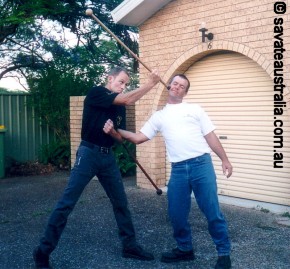
Vigny’s influence was felt not only in Europe but also in India .
While on leave in Europe Superintendent H.G Lang had studied Vigny’s walking stick combative method. Upon his return to the Agency Police in Kathiawar Lang taught selected Police officers from various districts. By the 1920s the Vigny system would become the principle method of stick defence for the Indian Police force.


His Highness Maharaja Sir Ghanshamsinhi, Raj Sahed of Dhrangadhra comments on Lang’s use of the walking stick-
“I had the occasion to witness a demonstration of a new art introduced by Mr. H.G Lang in the Agency Police of the use of the walking stick for purposes of self defence and was vastly impressed by his performance. It is really amazing how an ordinary walking stick can be made to serve as a very effective weapon of offence and defence. I consider it an undoubtedly useful art which would be worthwhile for every man to learn.”
During this period moves were underway to introduce the skills to the general public.
The Bombay Provincial Scout Council considered the physical exercise, self- defence and character building aspects of the walking stick method of self -defence highly beneficial for boy scouts.
J. T. Turner, Principal, Rajkumar College , and Member Bombay Provincial Scout Council comments –
“To see what a trained man can do with an ordinary walking stick both in defence and attack is an eye-opener for the uninitiated. I have been privileged to watch a display given by men trained by Mr. H .G. Lang, Superintendent Agency Police, and was much impressed by the sight. It is difficult to realise what an extremely business-like weapon an ordinary walking stick can make without seeing it: I was much impressed, and am convinced that all Boy Scouts should be taught to defend themselves in this way. The training involves physical exercises that are of great benefit in themselves, and teaches a boy to be quick on his feet and to keep cool in an emergency. I propose to introduce it as part of the training of Scouts here”.
With the passing of Professor Vigny many sources incorrectly assumed that his method of la canne also died out. But with all its tradition and undoubted skill it came as no surprise to learn that Vigny’s system would resurface, this time in the United States of America by way of Charles Yerkow. In 1943 Yerkow wrote the book “Modern Judo – The Complete Ju-Jitsu” which consisted of chapters covering Judo, Ju-Jitsu and the use of the walking stick for self-defence.
Basing his stick work on the Vigny-Lang method many of the classical guards, cuts and parries were clearly depicted.
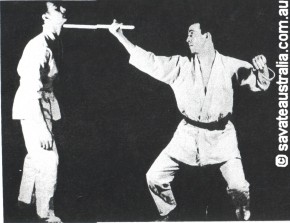
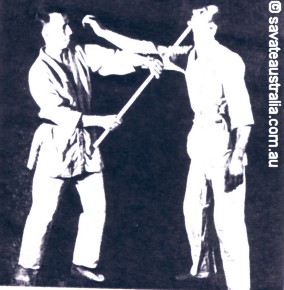
In 1972 a talented self-defence instructor named George B. Wallace added his own signature to the Vigny- Lang method by writing “Stick Fighting for Self- Defense”. Wallace’s book was based on street defence with the walking stick and included among other things cane and kicking integration, counters to body holds and defences while seated in a train or on a park bench. Wallace presented the long range and close quarter skills that had now become a trade-mark of the Vigny system, with careful thought to the environmental conditions of modern society.


Pierre Vigny was a man that had more than enough practical street experience. His system would not only encompass techniques for equal cane on cane confrontations but was also intended to combat adversaries armed with knives, clubs and batons and included ways to deal with multiple opponents and even aggressive animals.
With the gun and knife now facing more stringent legislation the carry options for law-abiding citizens are, in some parts of the world, almost non-existent. Fortunately the humble walking stick is currently still legal in almost all jurisdictions.
In looking for an excellent back up to one’s unarmed skills, the non-lethal use of a walking stick coupled with the Vigny method of using it is as relevant today as it was over 100 years ago.
New video now available: “La canne, The Walking Stick Method Of Self Defence Volume 2”
About the Author
Craig Gemeiner is the Founder of the Gemeiner Academy of European Combat Arts located on the Gold Coast, Australia. He is a Researcher and Historian of the European martial arts and teaches separate programmes in Street Savate, Sport Savate, Savate weaponry, fencing, English bare-knuckle boxing and women’s self- defence.
The Gemeiner Academy specialises in teaching the Vigny – Lang method of la canne and along with other individuals from around the world hopes to preserve the skills for future generations to appreciate.
Bibliography
Hutton, Alfred. The Sword and the Centuries or Old Sword Days and Old Sword Ways, London : Grant Richards 1901.
Lang, H.G. The Walking Method of Self-Defence by an Officer of the Indian Police, London : Athletic Publications, LTD.
Longhurst, Percy. Jiu-Jitsu and other Methods of Self- Defence, London : “The Bazaar, Exchange and Mart” Office. L’ art de la can, nevue Olympique 1912.
Wallace, George B. Stick Fighting for Self- Defense , United States of America : Walmac Books 1972.
Wright-Barton, E.W. Self-Defence with a walking stick, The Different Methods of Defending Oneself with a Walking –Stick or Umbrella when Attacked under Unequal Conditions, Pearson’s Magazine 1901.
Yerkow, Charles. Modern Judo, Basic and Advanced Technique. The complete Ju-Jitsu Library: The Military Service Publishing Co 1943.
NOTES
This article is © 2003 by Craig Gemeiner. My deepest gratitude to him for his kind permission in reposting his article to my site. Contents cannot be copied, republished or transmitted without prior consent from him. Copied from http://lacannevigny.wordpress.com/pierre-vigny/the-stick-fighting-method-of-pierre-vigny/.
You can contact him care of his various sites below:
http://gemeineracademy.wordpress.com/
http://www.savateaustralia.com/
http://lacannevigny.wordpress.com/
http://defensedanslarue.wordpress.com/
http://bootfighter.wordpress.com/http://www.freewebstore.org/bootfightercatalogue/index.aspx?pageid=1000146













0 comments:
Post a Comment